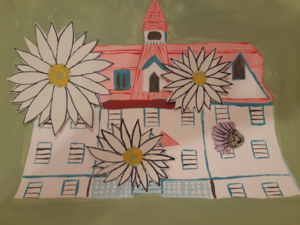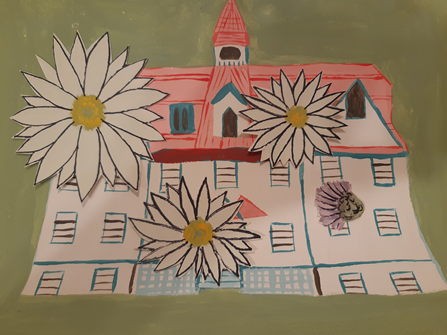KUPER’S ISLAND, PROVIDENCE FARM & ALL THE SNEAKY RESIDENTIAL SCHOOLS
Below is a painting of Providence Farm in Cowichan territory, popularly known as Duncan. I painted this as I set reflecting on my experience visiting this building. I shared this story in class, but to quickly recap: while at the koksilah music festival hosted at this farm, I was giddy with the excitement over our workshops, of the drum performances and the hip hop artists. I was taken by the flowers, fully in bloom everywhere. I looked up at the building and said, “what a beautiful building”. An audible scoff behind me. Two people ahead rolled their eyes. In the session that followed, the lovely elder running it mentioned, “we need to heal this place, this residential school that held our own”. A quick google search in 2020 shows that all the sisters of St. Ann have to say about it was that it was a “boarding school for native girls” and an “overflow school for Vic’s orphans”. Hiding behind words that aren’t quite fitting because they weren’t federally owned. But hell if it wasn’t a residential school. The girls who left it are the only ones we need to ask.
Kuper’s island gets “more media attention” (…kind of, it you can call it that….) because it was federally operated, and horrific to boot. The need for lifelong healing of many of the speakers from the documentary prove that, even through their remarkable resilience their ongoing trauma is plain as day. Unfortunately, Canada can maintain its polite-kid image by not fully reckoning with the scope of where these schools reached out to, and how hidden in plain sight they truly are. That overflow to providence? Those were girls being made to attend St. Ann’s in Vic before they ran out of space. Ran out of space because of how many young, Salish girls were forced to go there. This investigation highlighted the need for more investigations into the land I am living in and its comprehensive history, and trusting the oral feedback of those who have lived there far longer than myself.

My question: can you visit these sites in an emotionally responsible way if you have Indigenous children in your classroom? If yes, what are the parameters in which that would be possible?

Leave a Reply